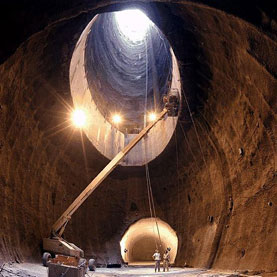 |
| Public Domain - US Government & [2] below |
Topics: CERN, Economy, Education, Jobs, Nuclear Fusion, Politics, Research, STEM
I recall before the Large Hadron Collider at CERN, there was supposed to be the Superconducting Super Collider in Waxahatchie, Texas. It was there, we were supposed to discover the "God Particle," and cement American leadership in High Energy Particle Physics research. Though the 90's during the saw economic surpluses, low unemployment and a robust economy of legend, part of the belt tightening included base closures (Bergstrom Air Force Base, for one to the now International Airport in Austin) and sadly, the Super Collider. That unfortunate shortsightedness delayed the discovery of The Higgs Boson, and as Neil deGrasse Tyson observed, saw the exodus of that scientific discovery from the United States. My wife's cousin was an engineer on the project that when it ended, so did his employment at the time.
I am incredulous that we naively see America as #1, yet cede our technological leadership by shortsightedness, fruitless pursuit of pseudoscience and political expediency. Science is not decided in the deified "market"; it is typically not self-funded nor self-sustaining; the Moon Launches, Shuttle missions and ISS were not all crowd sourced on Kick Starter, nor will any future endeavors to the asteroid belt and Mars require only benevolent billionaires. Our current national investment is in soundbite phrasings; empty words spoken by leaders to "tickle the ears" of their constituents and ensure their reelection in the next cycle. There is a direct proportional correlation to technological proficiency; national wealth and prosperity. An American Super Collider would have paid for itself from the PhD researchers to engineers, cafeteria workers and janitors, taxpayers all. CERN gives tours, and likely inspire another generation of scientists and engineers; educators [and] politicians with scales fallen from their eyes, widened with wonder. That wonder and spin off prosperity could have been shared in what is now a cavernous crater to our impolitic actions, "deep in the heart of Texas."
In my story on advances in smaller-scale, privately funded fusion reactor projects last week (“Finally, Fusion Takes Small Steps Toward Reality”), I stated that “Companies like Tri Alpha offer a path to fusion paved not with taxpayer dollars but with private-sector money—which ultimately is the only way to actually get something built.”
I considered that statement rather innocuous, but many readers disagreed, going so far as to call it “libertarian claptrap.” The advances I wrote about, said BarryG, “were EXACTLY only possible because they were very LITERALLY paved with taxpayer R&D.”
For the record, I didn’t say that only private-sector money is needed to bring new energy technologies, like fusion, to market; it’s undeniable that decades of taxpayer funding have been necessary to get the basic research to the point where companies like Tri Alpha and General Fusion can pursue newer approaches that could, plausibly, attract private sector investment. Both are essential; one will never work without the other. The key is defining the inflection point, at which the technology is mature enough and demand is robust enough to create a viable market that’s attractive to investors seeking a reasonable return. Any market dependent on long-term government support to sustain itself was never really a viable market in the first place. The trick is clearly defining “long-term.” [1]
If all had gone according to plan, the gargantuan U.S. high-energy physics project would have already found the Higgs particle, having solidly won the competition with its European competitor. Peter Higgs, in fact, might have collected his physics Nobel a few years earlier.
The Superconducting Super Collider (SSC) that would have graced the rolling prairies of Texas would have boasted energy 20 times larger than any accelerator ever constructed and might have been revealing whatever surprises that lay beyond the Higgs, allowing the U.S. to retain dominance in high-energy physics. Except the story didn’t play out according to script. Twenty years ago, on October 21, 1993, Congress officially killed the project, leaving behind more than vacant tunnel in the Texas earth. [2]
1. MIT Technology Review: Weighing the Cost of Big Science, Richard Martin
2. Scientific American: The Supercollider That Never Was, David Appell
Comments